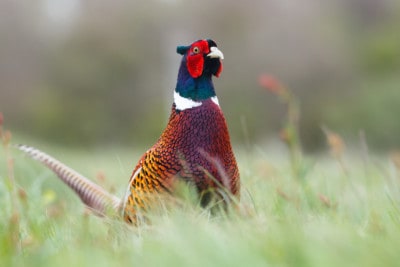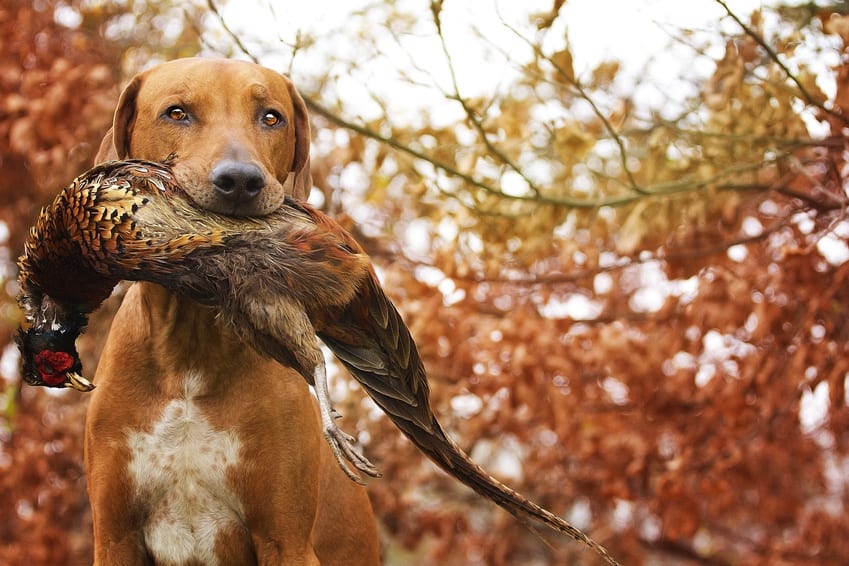So your going out for your pheasant hunt soon, and you’re having trouble gunning’ down some of these long tailed birds? Well we are here to help. Like any bird, Pheasants can be a sneaky bunch. If you or I had wings, we wouldn’t let some land creature like a human being gun us down too easily either right? Sometimes we just need a couple extra words of wisdom to turn our upcoming pheasant hunt into a wild success. Here are some tips for your upcoming pheasant hunt.
Pheasant hunting tips:
So where do we find pheasants? Well just like most game you’re trying to hunt, they love water!  Find a flock of pheasants in a grassland near a water source and you’ll be sure that you found one of their watering holes. Of course don’t get to close, and try to hit different water sources on different hunts. Pheasants aren’t so stupid to let us hunt them down day after day at the same spot!
Find a flock of pheasants in a grassland near a water source and you’ll be sure that you found one of their watering holes. Of course don’t get to close, and try to hit different water sources on different hunts. Pheasants aren’t so stupid to let us hunt them down day after day at the same spot!
Don’t hunt in the middle of the day
The best times for pheasant hunting are early, early morning, and in the evening. You can always catch some pheasants munching on some delicious bugs next to their neighborhood water source, so camp out there and find some pheasants right when the sun hits their back in the early morning. Get a good nights sleep before hand, because we need all the energy we can get to hunt these birds down!
Pheasant signals
When you head out for your hunt, immediately you’ll want to keep your eyes and ears peeled for signs of pheasants. First off, pheasants love the shade, so anywhere with shade, and where a lot of bugs might be is a plus. They like the water for meal time, but during the day we may want to check out spots like corn fields, or other types of fields with higher growing crops. These are all great places to find pheasants. Secondly, you’ll want to listen for some pheasant crowing. Try to find the sound on YouTube, or ask a hunting buddy to recreate it. He shouldn’t mind if he is a true hunting buddy, right?
Be super quiet
Pheasants aren’t all completely dumb. They know when they hear chatter, it means danger. When they here motors running, it means danger. When they hear barking, it means danger. Now this doesn’t mean we have to become the world’s best mimes, or Navy SEALS out there, but you catch our drift. Don’t cause a stir because if you get a good group of pheasants, and you’re being a loud mouth, you might have just caused your big hunt to be much less successful then planned
So some suggestions to stay quiet. Talk in whispers. Train your dog not to bark. Don’t be blasting off low percentage shots. Leave the stereo at home. Be smart out there!
Get some good boots!
You know what, pheasants love to get dirty and mucky. Yes I know, sorry friend, that means you’ll have to get down and dirty with them if you’ll want to gun these roosters down on your next hunt. Make sure you invest in some solid, water proof boots that will withstand the terrain.
Know they’re routine
These pheasants, just like us, have a routine that they abide by ritually, so you might as well know it like they’ve been your habits for years. These roosters start their day before sunrise for a bit of roosting. They love resting in high grass areas, which again is why they love those corn fields. A little later when the sun rises, they have their first meal. Inland pheasants may not have a trusty water source to go to, so they’ll feed and hang out on the outside of their grass or corn-fields. Of course, if they can find water, you’ll see them hanging out on the edge of the pond or lake we do at the beach in the summertime.
Then by midday. Pheasants take cover. This is the time of day where they are extra cautious and will avoid predators at any cost. Yes, that means you! This is the toughest time of the day to hunt pheasants. These birds will hide and run around in shady areas to avoid being taken advantage of.
But no worries, they have to eat somehow! Before bedtime in the late evening, they come back to feed in the spots they always feed in. This is why late evening and early morning are the best times to hunt.
So as you can see, feeding and hiding are main parts of their daily ritual, so if you can figure out the patterns in your hunting terrain, then you’re good to go.
To understand a bird, you must know its habits, which pheasants are no exception to! Study these roosters well, and you’ll no doubt shoot down more than if we didn’t
Use a shotgun
Just like for most bird hunting, you guessed it, we’ll be using a shotgun. This will be good especially for the pheasants that travel in flocks. Make sure you do some research and by the best shotgun for your hunt. Be safe with those things, because they are pretty powerful!
Man’s best friend
Your bird dog can be your biggest asset on your next hunt. How strong and trained is your bird dog? Is he really prepared to help you take down a few pheasants? Truth is, we should do our best to train our bird dogs to be the beasts of the wild.
First of all, certain dogs just make better bird hunters. Dogs like the pointer and certain types of retrievers make for great partners on your hunt. So make sure if your thinking about a bird dog, get a good breed. Second, make sure you spend sufficient time training your dog. If you put in the time, your investment will pay off in the long run with a great new life, let alone hunting, partner.
Also if you don’t own a dog, or don’t think you have the time to afford one, check out a local hunting club. We’re sure they can provide you with some guidance of how to get yourself a good ol’ canine hunting partner.
Just remember when you go on your hunts with your pup, there aren’t one, but two hunters heading out there! So it’s our responsibility to take sufficient food and water for two. Never neglect man’s best friends, feed them some good grub and water and they’ll reward you.
Corner the birds to the water
When driving these roosters, one of the best tactics to use is to drive the pheasants to the water. Corner them in a spot where at least two of their sides are to the water. They’ll have nowhere to go, and don’t you think that will make for an easier hunt? I thought so. Corner them in a group preferable and get them all with a couple shots of your trusty shotgun. Remember, don’t get too discouraged if you can’t outsmart these guys, because they’re cleverer than we might expect! Practice makes perfect with this skill.
Fence lines and ditches are your friends
It seems like most birds love to hang out on the edges of things, don’t you think? Well pheasants are no different. Especially during feeding hours, these spots are loaded with pheasants and other birds perching up. Look on the edge of water sources, cornfields, large tall grass fields, or road sides to find where your local pheasants hang out.
Take high cover
On our pheasant hunts, where should we post up and take cover? The short answer for you is to take the high ground. Having being on higher ground will give you the advantage when you encounter your soon to be hunted pheasants. Find a good spot that is a bit elevated and await tomorrow’s dinner!
Follow the rules
Before a hunt, always check state and local regulations for hunting. Even if you just look them over, it’s always good to jog your memory and be sure you’re not getting under Uncle Sam’s skin.
Enjoy your hunt!
So there are some tips for you to take on your next pheasant hunt. Now remember, the best way to know the animal you are hunting is to spend time around it. If we could transform into pheasants, we would, but we can’t, so try to get as close to the animal as possible. Always be safe with your firearm, follow the 4 gun rules that every hunting should know. With some time under your belt you’ll be gunning down these roosting winged creatures in no time!


Georgia Boothe says
I’m going pheasant hunting for the first time, and even though I’m going with some people who have a lot of experience I want to make sure I know what’s going on. This article gave me some great information on what to expect when I go! I’m really glad you mentioned taking the high cover because now I know that we’ll be doing a little hiking and I can be prepared.